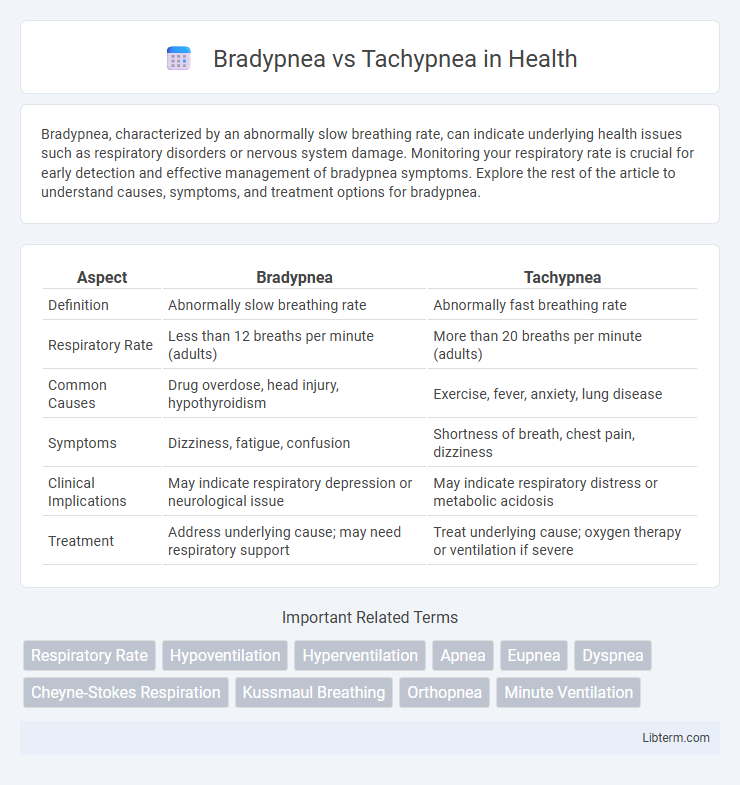Bradypnea, characterized by an abnormally slow breathing rate, can indicate underlying health issues such as respiratory disorders or nervous system damage. Monitoring your respiratory rate is crucial for early detection and effective management of bradypnea symptoms. Explore the rest of the article to understand causes, symptoms, and treatment options for bradypnea.
Table of Comparison
| Aspect | Bradypnea | Tachypnea |
|---|---|---|
| Definition | Abnormally slow breathing rate | Abnormally fast breathing rate |
| Respiratory Rate | Less than 12 breaths per minute (adults) | More than 20 breaths per minute (adults) |
| Common Causes | Drug overdose, head injury, hypothyroidism | Exercise, fever, anxiety, lung disease |
| Symptoms | Dizziness, fatigue, confusion | Shortness of breath, chest pain, dizziness |
| Clinical Implications | May indicate respiratory depression or neurological issue | May indicate respiratory distress or metabolic acidosis |
| Treatment | Address underlying cause; may need respiratory support | Treat underlying cause; oxygen therapy or ventilation if severe |
Understanding Bradypnea and Tachypnea
Bradypnea refers to an abnormally slow respiratory rate, typically fewer than 12 breaths per minute in adults, which can indicate underlying conditions such as respiratory depression or metabolic disorders. Tachypnea is characterized by an increased respiratory rate, usually over 20 breaths per minute, often resulting from hypoxia, fever, or pulmonary diseases like pneumonia or chronic obstructive pulmonary disease (COPD). Monitoring and distinguishing between bradypnea and tachypnea is critical for diagnosing respiratory dysfunction and guiding appropriate medical interventions.
Definition of Bradypnea
Bradypnea is defined as an abnormally slow respiratory rate, typically fewer than 12 breaths per minute in adults, indicating reduced ventilation efficiency. This condition contrasts with tachypnea, which is characterized by an increased respiratory rate exceeding 20 breaths per minute, often signaling respiratory distress or metabolic imbalance. Recognizing the respiratory rate thresholds is critical for diagnosing and managing underlying pathologies associated with abnormal breathing patterns.
Definition of Tachypnea
Tachypnea is defined as an abnormally rapid respiratory rate, typically exceeding 20 breaths per minute in adults, indicating increased respiratory demand or distress. It contrasts with bradypnea, which is characterized by a slower than normal breathing rate, usually fewer than 12 breaths per minute. Tachypnea often signals underlying conditions such as hypoxemia, fever, or metabolic acidosis requiring prompt medical evaluation.
Key Differences Between Bradypnea and Tachypnea
Bradypnea is characterized by abnormally slow breathing rates, typically fewer than 12 breaths per minute in adults, while tachypnea refers to abnormally rapid breathing, usually exceeding 20 breaths per minute. Bradypnea often indicates underlying conditions such as drug overdose, hypothyroidism, or brain injury, whereas tachypnea is commonly associated with respiratory distress, fever, or metabolic acidosis. The key physiological impact of bradypnea is reduced oxygen intake, potentially leading to hypoxia, whereas tachypnea results in excessive ventilation, potentially causing respiratory alkalosis.
Causes of Bradypnea
Bradypnea, characterized by abnormally slow breathing rates below 12 breaths per minute in adults, is often caused by conditions such as hypothyroidism, drug overdose (notably opioids or sedatives), brain injuries affecting the respiratory centers, and severe metabolic disorders. In contrast, tachypnea involves rapid breathing exceeding 20 breaths per minute, frequently triggered by fever, hypoxia, acidosis, or lung diseases like pneumonia and asthma. Understanding the underlying causes of bradypnea is critical for accurate diagnosis and effective treatment in clinical settings.
Causes of Tachypnea
Tachypnea, characterized by an abnormally rapid breathing rate exceeding 20 breaths per minute in adults, is commonly caused by conditions such as fever, anxiety, lung diseases like pneumonia or asthma, metabolic acidosis, and heart failure. Bradypnea, in contrast, involves abnormally slow breathing, typically under 12 breaths per minute, often resulting from drug overdose, increased intracranial pressure, or hypothyroidism. Understanding the underlying cause of tachypnea is crucial for accurate diagnosis and effective treatment.
Symptoms and Clinical Manifestations
Bradypnea presents as abnormally slow breathing, typically fewer than 12 breaths per minute, with symptoms such as dizziness, fatigue, and confusion due to insufficient oxygen intake. Tachypnea involves rapid, shallow breathing exceeding 20 breaths per minute, often accompanied by shortness of breath, chest discomfort, and an increased respiratory rate as the body attempts to compensate for hypoxia or acidosis. Clinical manifestations of bradypnea may indicate respiratory depression or neurological conditions, while tachypnea often signals underlying respiratory distress, fever, or metabolic imbalance.
Diagnostic Approaches
Bradypnea diagnostic approaches primarily involve measuring respiratory rate below 12 breaths per minute using clinical observation and pulse oximetry to assess oxygen saturation levels. Tachypnea diagnosis requires monitoring respiratory rates above 20 breaths per minute, often supplemented by arterial blood gas analysis to evaluate oxygen and carbon dioxide levels. Both conditions benefit from chest X-rays and pulmonary function tests to identify underlying causes such as lung disease or neurological disorders.
Treatment and Management Strategies
Bradypnea treatment involves addressing underlying causes such as hypothyroidism, neurological disorders, or opioid overdose, often requiring respiratory support like oxygen therapy or mechanical ventilation. Tachypnea management focuses on treating conditions like fever, infections, or heart failure, utilizing medications such as bronchodilators, antibiotics, or diuretics alongside oxygen administration to improve breathing. Continuous monitoring and timely intervention are essential in both cases to prevent respiratory failure and ensure optimal patient outcomes.
Prognosis and Complications
Bradypnea, characterized by abnormally slow breathing, often indicates underlying conditions such as opioid overdose or neurological disorders, with prognosis depending on prompt identification and treatment to prevent hypoxia and respiratory failure. Tachypnea, defined by rapid breathing, commonly results from infections, metabolic acidosis, or lung diseases, and its prognosis varies based on the severity and cause, with complications including respiratory exhaustion and cardiovascular strain. Early intervention in both conditions is critical to mitigate risks like hypoxemia, organ dysfunction, and long-term respiratory impairment.
Bradypnea Infographic

 libterm.com
libterm.com